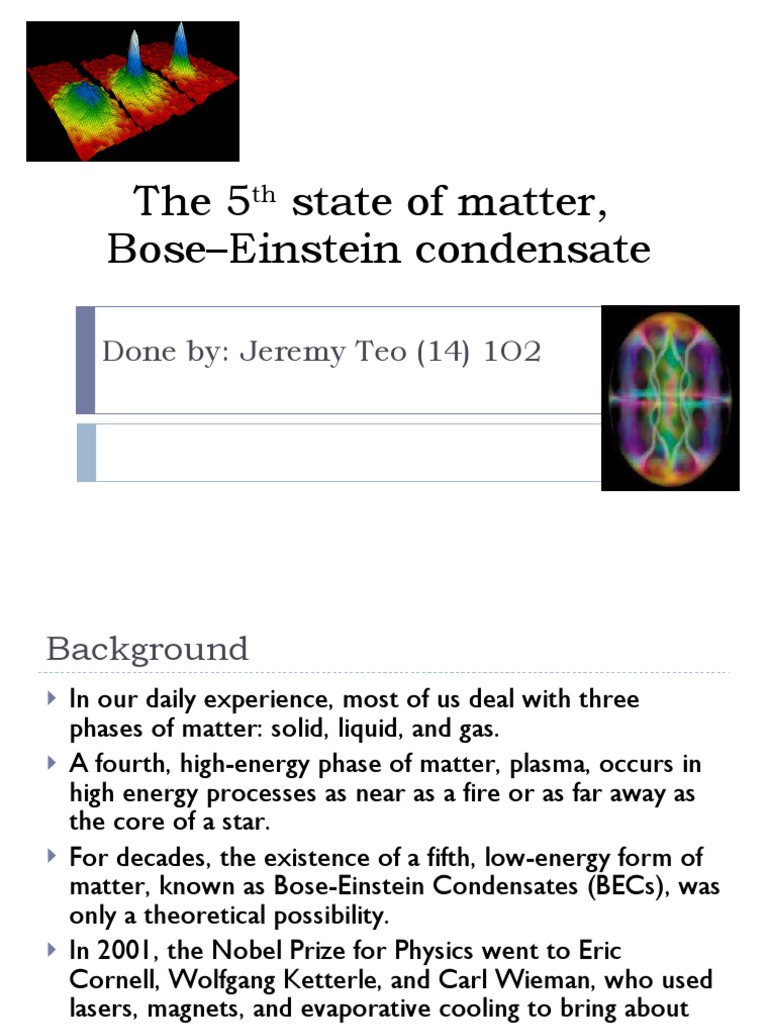Throughout the annals of scientific exploration, our understanding of matter has undergone a remarkable evolution. Traditionally, we have categorized matter into four fundamental states: solid, liquid, gas, and plasma. However, the discovery of the fifth state of matter—Bose-Einstein condensate (BEC)—challenges conventional paradigms and opens avenues for profound inquiry. Why does the fifth state of matter matter? This question not only piques intellectual curiosity but also invites one to delve into the intricate tapestry of physics that underpins our universe.
At the heart of the fifth state of matter lies the phenomenon of quantum mechanics, an enigmatic domain where particles exhibit behaviors that defy classical intuitions. BEC occurs at temperatures very close to absolute zero, where a group of atoms is cooled to such an extent that they occupy the same quantum state. This coherence among the particles leads to intriguing properties that contrast sharply with those of classical states of matter. Consider this: at these frigid temperatures, individual atoms lose their identity, behaving as a single entity. This transition captivates physicists and raises critical questions about the nature of reality itself.
One of the most salient aspects of BEC is its connection to the concept of wave-particle duality. At elevated temperatures, atoms behave like discrete particles, but as they condense into a BEC, quantum wave properties dominate. This duality presents a challenge to our classical understanding of matter. How can one entity simultaneously exhibit particle and wave characteristics? Such questions compel scientists not only to reassess existing theoretical frameworks but also to develop innovative models that can accommodate these peculiar behaviors.
The implications of BEC extend far beyond academic curiosity. From an applied perspective, exploring the fifth state of matter holds promise for revolutionizing technology. For instance, researchers are investigating the potential of BECs in the realm of quantum computing. Traditional computers rely on bits as the smallest unit of data, operating on either 0 or 1. In contrast, BECs could facilitate the development of qubits, which can exist simultaneously in multiple states due to superposition. This capability enables unprecedented computational power, potentially solving complex problems that are currently intractable.
Furthermore, BECs offer insights into fundamental forces of nature. For example, understanding the interactions within condensates can illuminate the behavior of high-energy particles in quantum field theory. Researchers are now poised to explore phenomena such as dark matter and dark energy, constituents that remain elusive in our current understanding of the universe. By utilizing BECs as experimental platforms, scientists hope to unravel the mysteries underpinning these cosmic puzzles. Isn’t it fascinating how the exploration of a seemingly arcane state of matter can unravel the fabric of the cosmos?
Moreover, BECs have practical applications in metrology, the science of measurement. At extreme temperatures, the precision of measurements can reach unprecedented levels. This characteristic is particularly valuable in refining technologies such as atomic clocks, which underpin global positioning systems (GPS) and telecommunications. The ramifications extend into various scientific disciplines. Enhanced measurement techniques can lead to breakthroughs in fundamental physics, chemistry, and even biology, enabling discoveries that were previously beyond our grasp.
As we contemplate the significance of the fifth state of matter, it is crucial to recognize that it challenges our perceptions and ignites imagination. When researchers venture into the realm of BEC, they probe the boundaries of knowledge, embarking on a quest to elucidate the complexities of the natural world. The playful question emerges: Can the enigmatic behavior of BECs help us understand the very fabric of reality itself?
An examination of BEC also encourages interdisciplinary collaboration. The intricacies of quantum behavior beckon physicists, chemists, engineers, and computer scientists to collaborate. Such interactions yield fertile ground for innovation as diverse insights converge. When multidisciplinary teams tackle the challenges posed by BECs, they blend perspectives that transcend isolated fields of study, accelerating progress. This synergy cultivates a holistic understanding of systems and phenomena, exemplifying how science thrives when barriers are dismantled.
Nonetheless, while the potential of BEC is undeniably inspiring, it is accompanied by challenges. The conditions required to create and maintain Bose-Einstein condensates are exceptionally rigorous. Researchers must navigate technical constraints and address limitations inherent to current experimental setups. This reality necessitates continuous advancements in cryogenic technology and quantum manipulation techniques. Acknowledging these challenges not only emphasizes the complexities of discovery but also underscores the perseverance vital to scientific inquiry.
In conclusion, the exploration of the fifth state of matter is a noteworthy endeavor that transcends the confines of theoretical physics. Its implications resonate across various domains, encompassing technology, fundamental science, and collaborative interdisciplinary efforts. While the mysteries that shroud Bose-Einstein condensates may prove formidable, they also foster a sense of wonder. As researchers strive to unlock the secrets of this remarkable state, we are reminded of the enduring human quest for knowledge and understanding—the essence of science itself. In navigating this uncharted territory, we must ask ourselves: What lies beyond our current comprehension, waiting to be discovered within the depths of matter?












